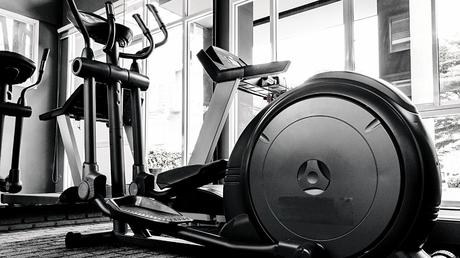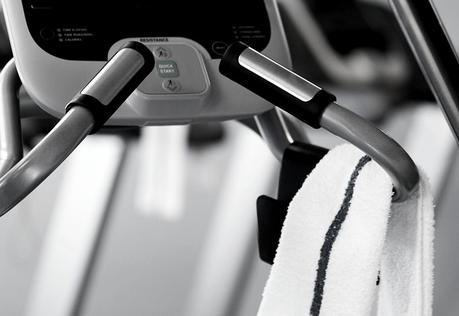Looking to work your stomach and core on the elliptical machine? Here’s how to do it properly for maximum effectiveness.

- Why the Elliptical is a Great Choice for Targeting the Stomach
- How to Work Your Stomach and Core on the Elliptical Like a Pro
- What is better for abs – treadmill or elliptical?
- Are elliptical trainers good for losing belly fat?
- The Bottom Line
When you think of the elliptical machine, your mind probably jumps straight to “It’s a cardio machine for weight loss.”
That’s what it is and what’s always been, a fat-burner extraordinaire.
However, the more I use them, the more I come to see that the benefits of elliptical machines extend far beyond just cardio.
I’ve stopped focusing on the calories burned on the elliptical, and instead begun looking for ways to use it to train my muscles—not just my legs, but my arms, and, most important of all, my core.
Below, I want to walk you through how to use the elliptical machine to work your stomach muscles, to build that rock-hard six-pack you know you want.
We’ll look at what the machine does overall (all those benefits I mentioned above), how exactly it works your abs, what you can do to max out the abs focus of your workouts, and to wrap it up, answer a few questions to help you get to know your machine better.
By the end of this post, you’ll be ready to shred your core using the elliptical machine!

Why the Elliptical is a Great Choice for Targeting the Stomach
The elliptical machine is one of the single most effective cardio machines in the gym. Not only does it give you a great cardio training session, but it offers a lot of pretty epic benefits:
 Excellent Muscle Training
Excellent Muscle Training

Take a look at all the muscles worked on the elliptical machine:
- Upper body: chest, back, triceps, biceps, shoulders, and forearms
- Core: Abs, obliques, spinal supports
- Lower body: quads, glutes, hamstrings, and calves
Really, what muscles doesn’t the elliptical machine work? Not many, that’s for sure!
None of the other cardio machines in the gym can work as many muscles as the elliptical. The next-best is the rowing machine, and the focus is entirely on your “pull” muscles, but there’s no engagement of the “push” muscles.
The elliptical not only engages more muscles, but actually allows you to focus on those muscles. For example, building glutes on the elliptical is as easy as increasing the incline to the max to simulate stair-climbing. To shred your quads, try squat-walking.
To hammer your upper body, work the handles with your arms and use your legs as little as possible.
Ultimately, the elliptical delivers a more effective full-body workout than any other cardio machine in the gym.
 Great for HIIT
Great for HIIT

HIIT is a highly effective option for people who A) want to get a more effective workout, and B) don’t have hours to spend in the gym every day. With the alternating intervals of low and high-intensity workout, you can burn a ton of calories, build muscle, and boost your metabolism to the max.
Not all cardio machines make it easy for you to get in a HIIT workout. Take the treadmill, for example. You have to hit multiple buttons to increase the speed to sprint speed, then again try and hit those buttons while sprinting to reduce back to low-intensity jogging or walking speed.

For an elliptical HIIT workout, all you have to do is pedal faster. No buttons need pressing, no adjustments need making. Just pedal your heart out as fast as you can for the 30- or 60-second high intensity interval, then slow down again for the low-intensity interval.
You can adjust the incline or resistance if you want, but that’s just an added bonus. The simplicity of the elliptical makes it ideal for HIIT workouts.
 Highly Versatile
Highly Versatile

With the elliptical, you can train any way you want!
- Pump the pedals harder to work your upper body
- Squeeze your core to engage your abs, obliques, and glutes with every step
- Try going backwards on the elliptical to strengthen the muscles supporting your knees
- Squat-walk to target your quads
- Walk at an incline to hammer your glutes
No other cardio machine can match the versatility of the elliptical.
 Effective Low-Impact Weight Loss
Effective Low-Impact Weight Loss

Last, but definitely not least, you’ll find that losing weight with an elliptical is a lot safer than nearly every other cardio machine in the gym. It all comes down to impact!
Every time you step, you lift your foot off the ground. When you set it down and transfer your weight forward onto it, there is a bit of impact on your joints (in your feet, ankles, knees, hips, and spine).
Certain exercises—like running and jumping—are HIGH-impact, meaning the amount of impact on your joints is significant. Over time, a lot of high-impact exercise can lead to injuries in your joints, bones, or muscles.
Low-impact exercise, on the other hand, is much gentler on your skeletal system. There is no wear and tear on your bones, joints, and muscles, so the risk of injury is far lower.
A smart trainee will combine high-impact exercise with low-impact exercise (or even near-zero-impact exercise like elliptical training) to maximize the strength of their skeletal system while also allowing for sufficient recovery time.
How to Work Your Stomach and Core on the Elliptical Like a Pro
Now that we have a solid understanding of why the elliptical trainer is such a great choice for hitting your mid-section, here are some pro tips for making the most of your time on the elliptical:
 Stand straight and clench your abs.
Stand straight and clench your abs.

With some ellipticals, there will be the temptation to lean forward and support the weight of your upper body on the handles. FIGHT THAT TEMPTATION!
Focus on keeping your posture as upright as possible: head up, shoulders back, spine straight, and center of gravity balanced over your feet.
To facilitate this, imagine yourself squeezing your abs and pulling your belly button in as far as you can, until it touches your spine.
Do it without holding your breath, but let your muscles do the work of tightening the muscles around your belly button and pulling them inward. This will engage your abs and help to encourage a more natural posture.

 Release the handles.
Release the handles.

Initially, you’ll want to hang onto the handles to help you get into the groove of the workout, really feel the stride and set the pace.
But once you’re in the groove, try letting go of the handlebars as often as you can, for as long as you can. It will feel strange at first, and you’ll probably wobble a bit, but over time, it will get easier.
The reason for this is that elliptical machines move your body in a manner slightly different from anything you’re accustomed to. It’s not quite a walk and not quite a pedal, but something in between.
The muscles that support your spine and upper body through those familiar forms of movement will need to adapt and grow strong in order to keep you upright in this new form of movement. Releasing the handlebars and using your core muscles forces them to grow strong and maintain your balance.
 Increase the resistance.
Increase the resistance.

The greater the resistance, the harder your muscles will have to work to keep up the pace. Don’t just stick to the “0” setting—that’s too easy!
Instead, start working with higher resistance—incrementally at first, but working your way up to max resistance.
Your muscles will work harder to push against the magnetic resistance of the flywheel, and you’ll see an increase in your core strength.
 Focus on core engagement.
Focus on core engagement.

To give your core some serious love, focus on the way that you push with every step. Squeeze your abs tight, and use them to push your arms forward, twist your torso, and push your legs backward.
Do the same with the “pulling” side of the movement, too.
It will take some practice, but by focusing on the way your muscles squeeze with every stride, you can max out core engagement. Repeatedly squeezing your abs is the key to building strength!
 Mix it up.
Mix it up.

Don’t just rely on the elliptical to work out your core.
Instead, use the elliptical as a “finisher” to help you push your muscles to failure after you’ve put in the time strengthening the muscles with exercises like crunches, bicycles, leg raises, and all those other awesome abs-focused resistance training exercises.
What is better for abs – treadmill or elliptical?
The elliptical is the better abs-focused machine by far.
While there is some engagement of your core with every step on the treadmill, the activation increases when you add in the twisting motion of your upper body (moving antagonistically with your lower body).
Following the advice above, you can get a truly spectacular abs workout every time you step onto the elliptical.
Are elliptical trainers good for losing belly fat?
Absolutely! Because ellipticals engage so many muscles, it increases the probability that you’ll burn body fat through your training.
There is no way to “spot reduce” or target just the fat on your belly—the only way to lose belly fat is to get rid of all your body fat together.
Few cardio machines are as effective for total body fat burning as the elliptical is.
The Bottom Line
The elliptical machine was created to specifically target your abs (along with the rest of the muscles engaged), making it a truly effective option for burning fat and building core strength.
The advice I shared above will help you to turn every elliptical training session into a better, more abs-focused workout that will deliver real results over time—not just stronger abs, but improved balance and greater core strength overall.
Now that’s a benefit of elliptical trainers you can absolutely love!
More Elliptical Guides and Articles
Why Do My Feet Go Numb on the Elliptical Trainer? (and How to Fix It). Numb feet on the elliptical can be a real pain in the butt and can cut short a good workout. Here are the primary causes of foot numbness on the elliptical and how to fix it.
How Much Do Ellipticals Cost? (44 Different Models Compared). Ellipticals can be a costly investment in your workout goals. Here is a look at how much each type of elliptical costs and how much to spend on one.
